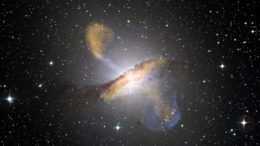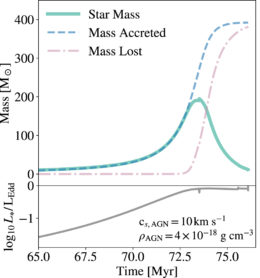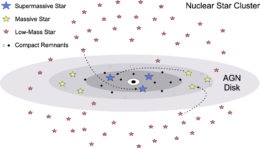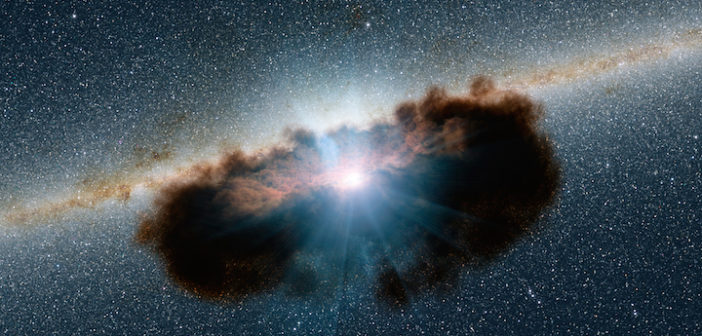Active galactic nuclei are exactly what they sound like — central regions of galaxies that emit enormous amounts of energy. Typically, they consist of a supermassive black hole surrounded by a hot disk of material being accreted onto the black hole. Hardly the most hospitable environment, but stars can still live in these surroundings!

This composite image reveals Centaurus A, a galaxy with an active nucleus spewing fast-moving jets into its surroundings. [ESO/WFI (Optical); MPIfR/ESO/APEX/A.Weiss et al. (Submillimetre); NASA/CXC/CfA/R.Kraft et al. (X-ray)]
Actively Hostile Environments
It would be hard to overstate how energetic active galactic nuclei (AGN) are. Some can outshine the rest of their host galaxy at almost all detectable wavelengths! Spectra of material near the central black hole have shown that AGN environments contain a higher abundance of heavier elements than the environment of our Sun. So it’s possible that those heavier elements were produced in the accretion disk and then swept closer in towards the black hole.
But what produces heavier elements? Stars! Stars can be found near the central supermassive black holes of galaxies, like the Milky Way’s Sagittarius A*, but AGN have far more extreme environments than our placid central black hole. So what sort of stars live in AGN environments? A recent study led by Matteo Cantiello (Flatiron Institute/ Princeton University) dives into this question.

The mass and brightness of an AGN star over time. This star was modeled under specific AGN conditions. LEdd stands for Eddington luminosity, which is the maximum brightness a star can have when it has balanced its outward radiative pressure with its inward gravitational contraction. Mass loss starts roughly around when the star’s luminosity reaches the Eddington luminosity. [Cantiello et al. 2021]
What Massive Stars Make
Cantiello and collaborators were especially interested in how the evolution of stars in AGN environments differs from stellar evolution in calmer environments. To get where they are, AGN stars have to either form in accretion disks or get captured and pulled into the disks. Both models are viable and supported by looking at stellar populations around central black holes that were previously active, like Sagittarius A*.
Once in the disk, stars can rapidly accrete material and become hundreds of times more massive than the Sun. Massive stars experience more internal mixing than less massive stars, so the contents of a massive star are evenly distributed within the star’s interior. This is very different from stars like our Sun, where the outer layers of the star contain lighter elements like hydrogen and helium while inner layers are dominated by heavier elements.
However, massive stars are also unstable and can lose mass quickly as they teeter between expansion and collapse. Their sheer bulk also means that they will end their lives through core collapse — forming heavier and heavier elements through fusion until they run out of material to fuse and collapse onto themselves. The bottom line is that AGN stars are good at producing heavy elements and sending those elements out into the accretion disk.

A schematic showing stellar evolution in the accretion disk of an AGN. Low mass stars can be formed in or accreted by the disk, where they gain mass and eventually evolve to leave behind compact remnants near the center of the disk. [Cantiello et al. 2021]
Signs of Stellar Life and Death
So Cantiello and collaborators identified two signatures of AGN stars: high abundances of heavy elements and compact stellar remnants left behind from core collapse. There are studies showing evidence for the first signature, and interestingly, this abundance of heavy elements doesn’t seem to depend on redshift.
The second signature is a bit trickier to tease out. Before gravitational-wave observatories, our best bet would be to search for the explosions associated with core collapse in the accretion disk of an AGN. Now, we can also look for the gravitational-wave signatures of the mergers of dense objects, with an expectation of how often these mergers would occur.
Sagittarius A* is a good proving ground for the findings of this study, since our galaxy’s nucleus may approximate the aftermath of an AGN. With predictions in hand, it’s now time to observe!
Citation
“Stellar Evolution in AGN Disks,” Matteo Cantiello et al 2021 ApJ 910 94. doi:10.3847/1538-4357/abdf4f

4 Comments
Pingback: From AAS NOVA : “Signs of Extreme Survivor Stars” | sciencesprings
Pingback: Ewolucja gwiazd w dyskach AGN – PTMA Kraków
Pingback: Ewolucja gwiazd w dyskach AGN – Astronomia Śląska
Pingback: Bad Astronomy | Huge stars might be born in accretion disks around supermassive black - The Zanesville Daily Times